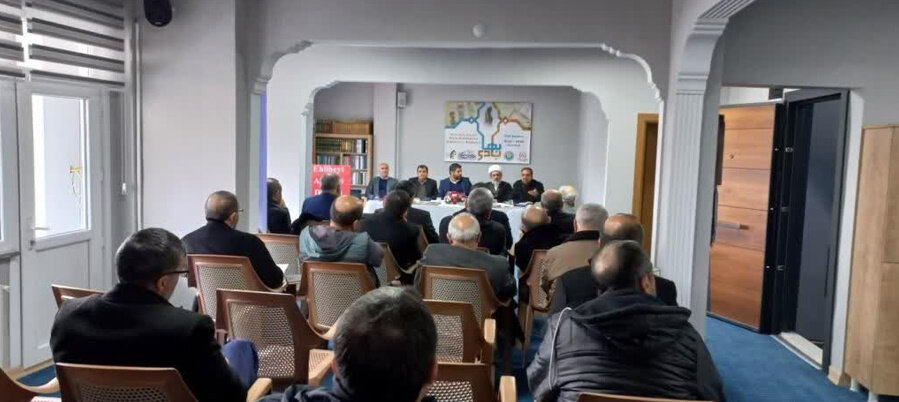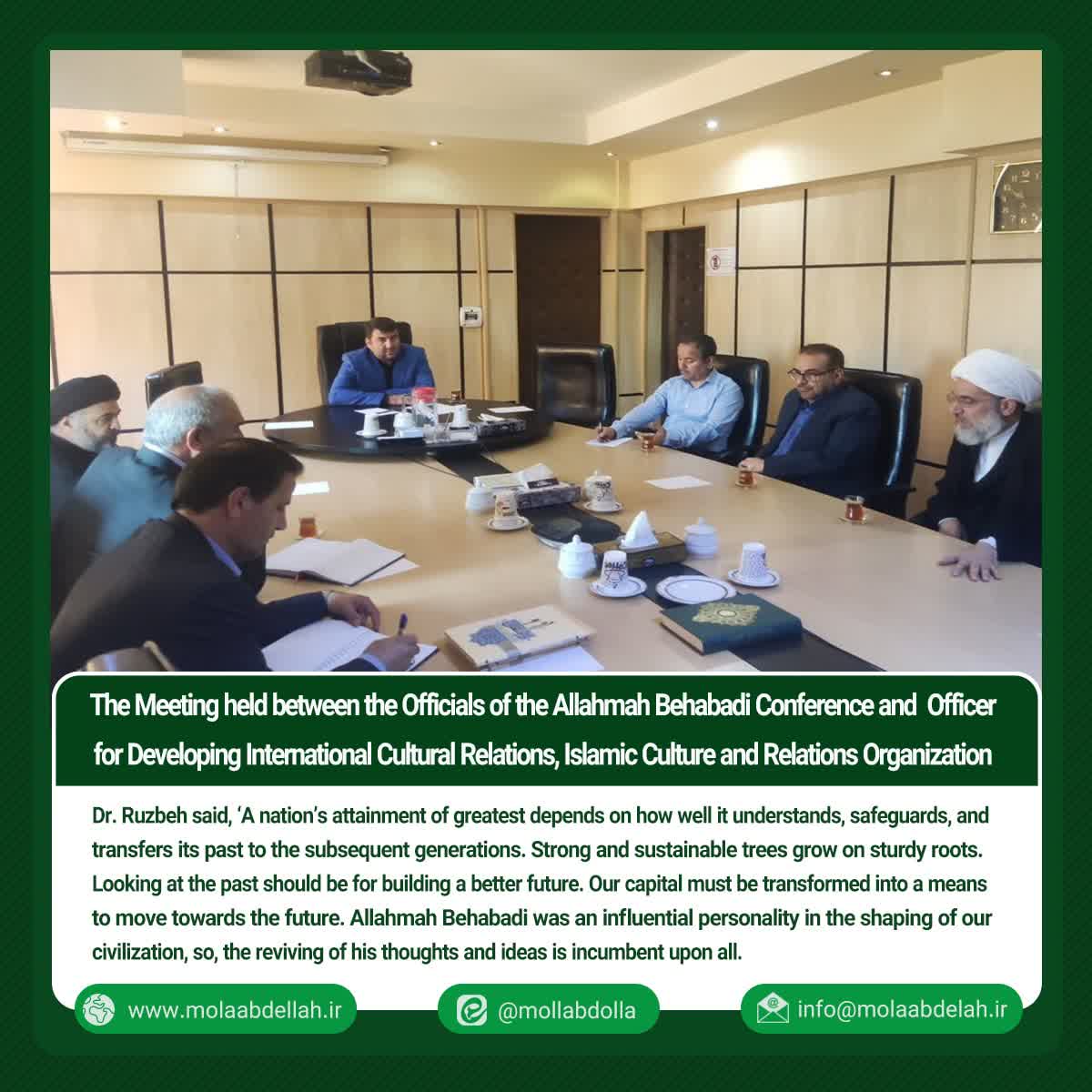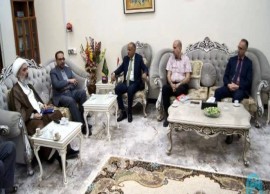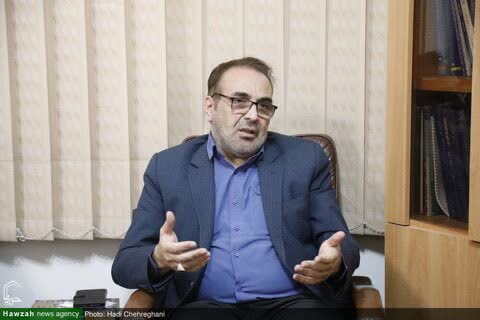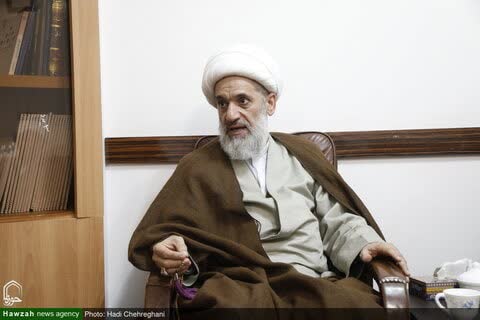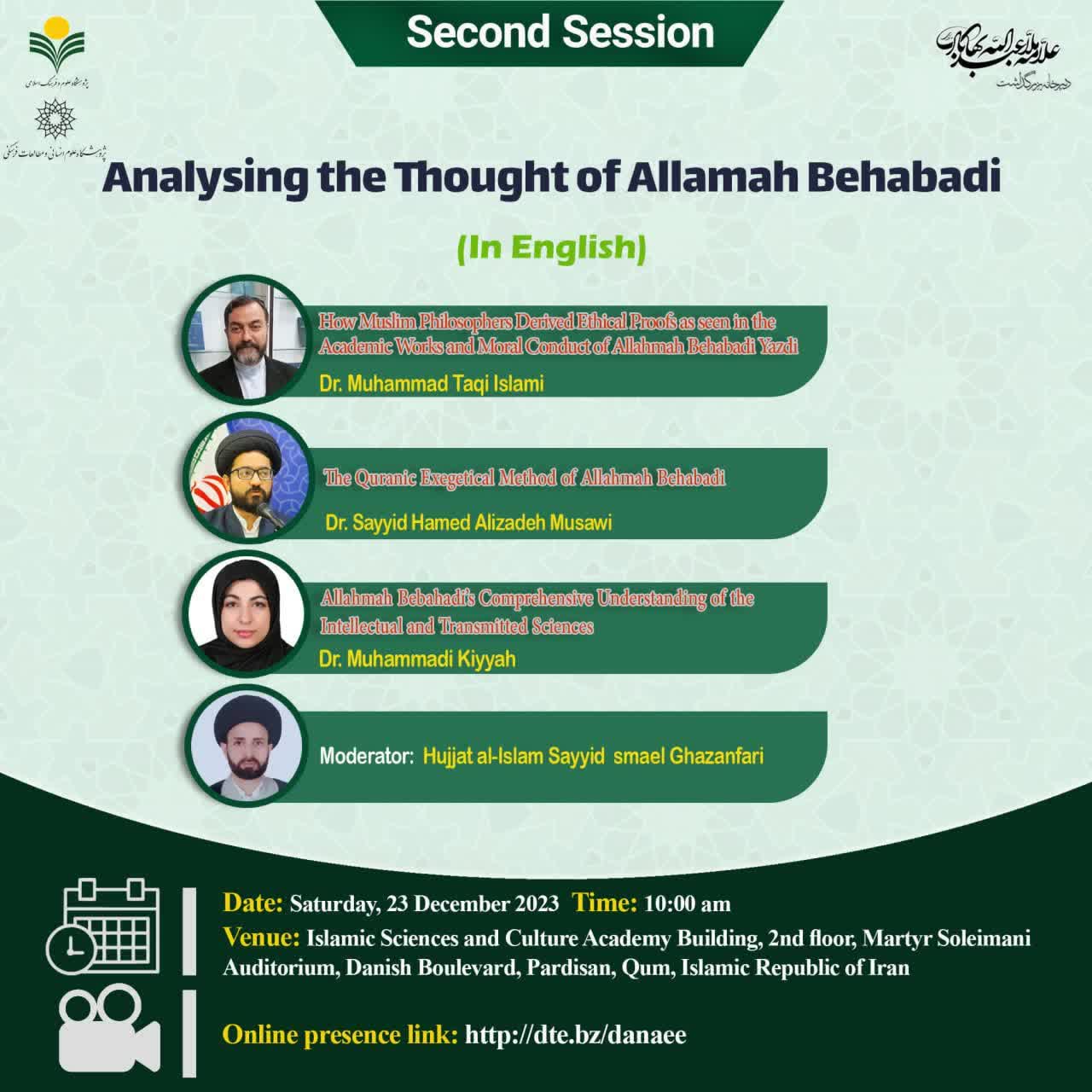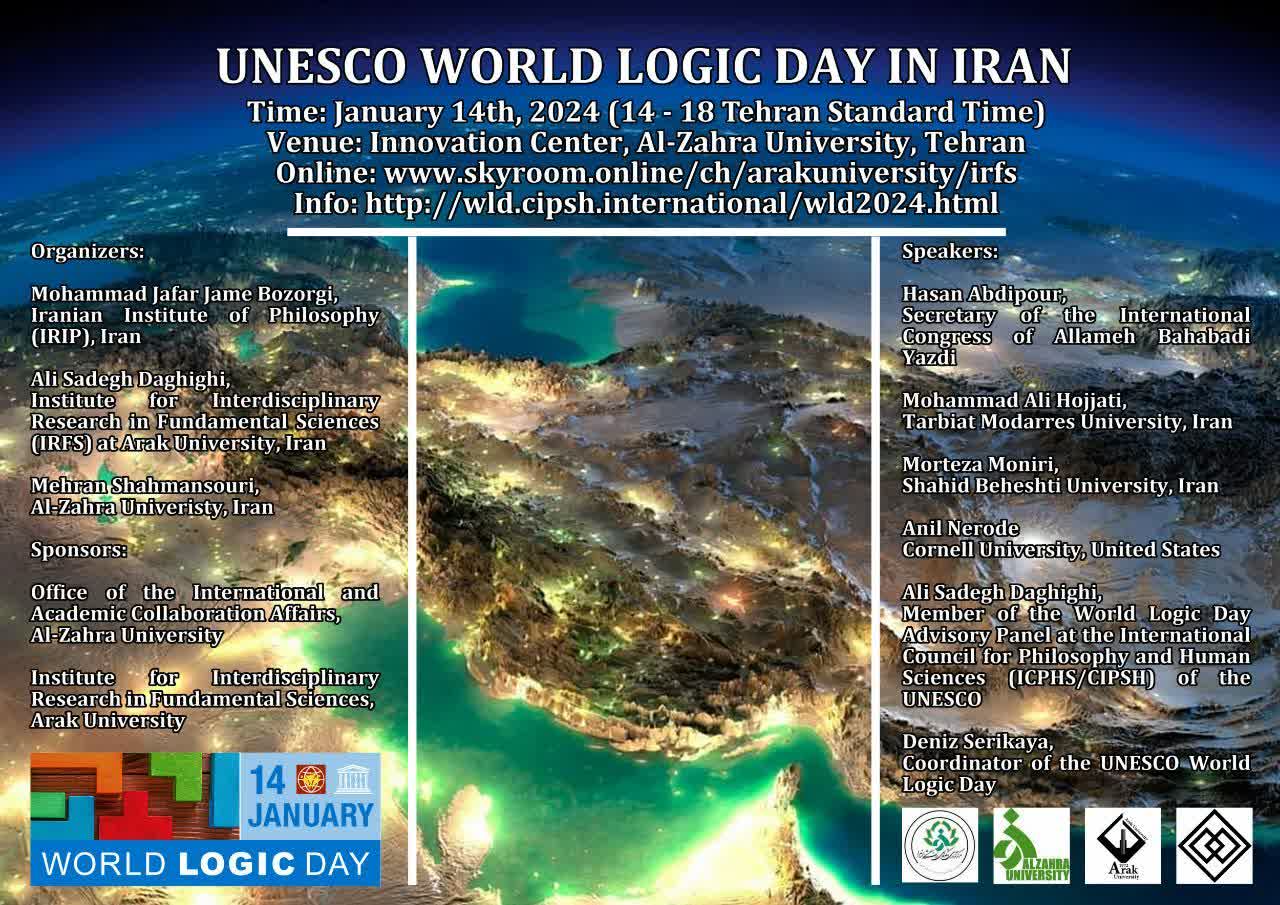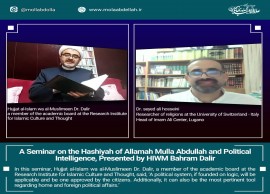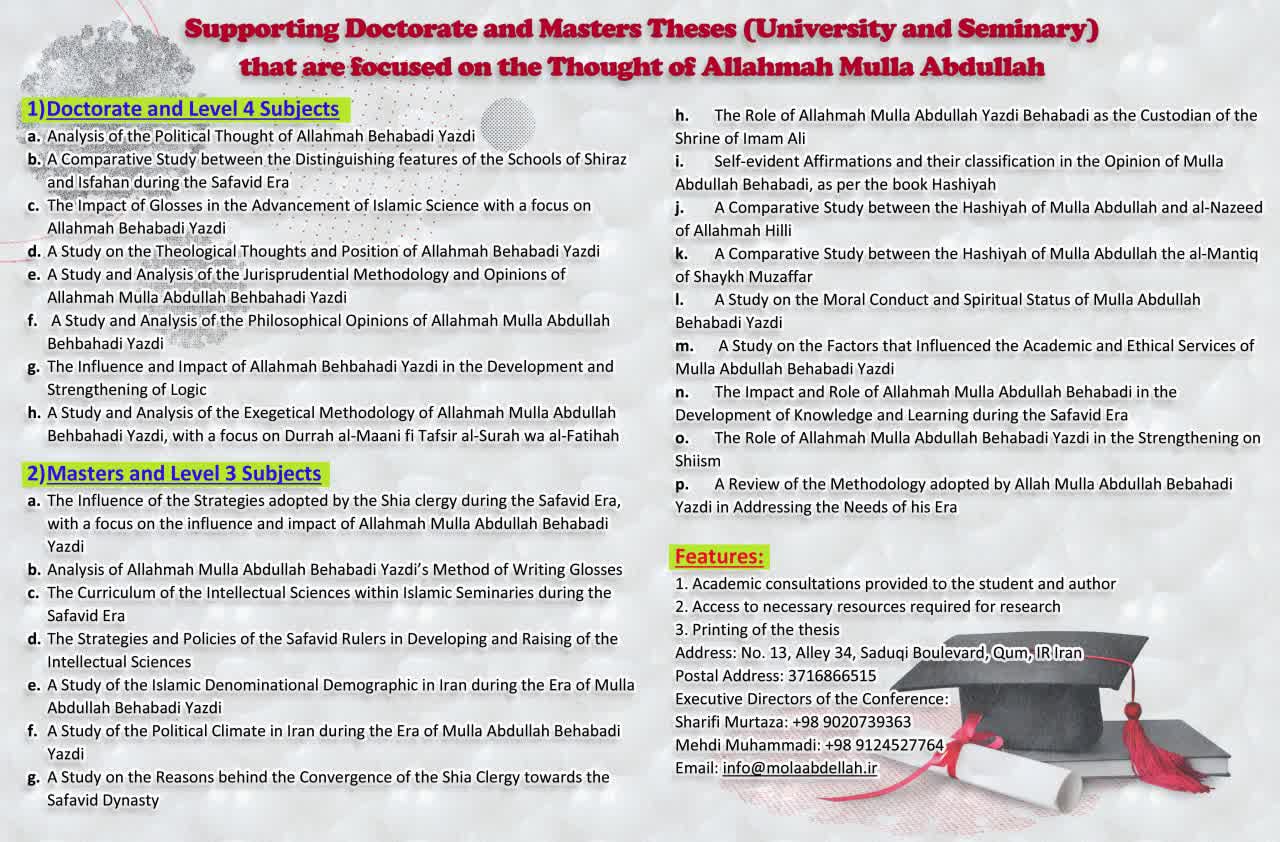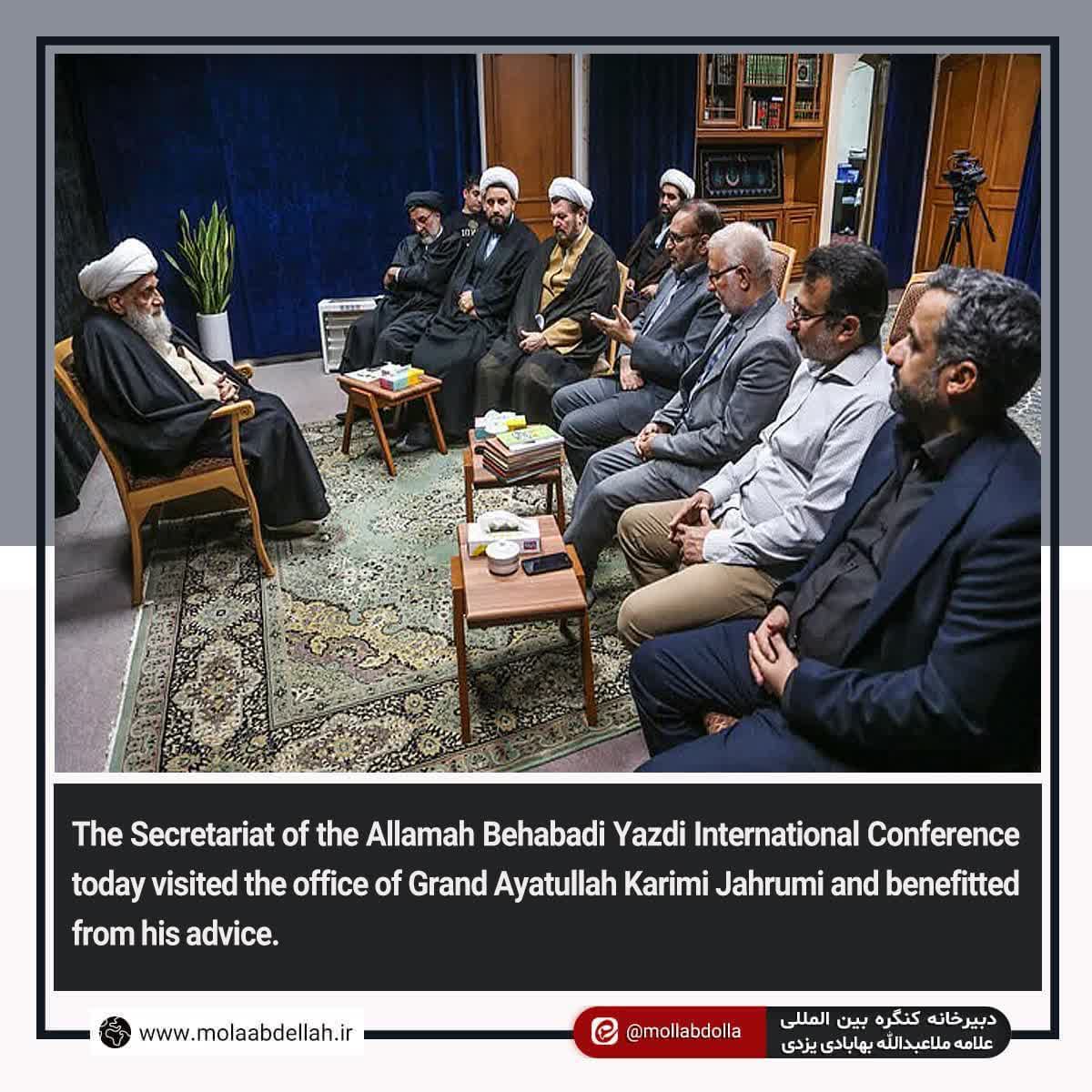Moderator:
Thanks to Allah the almighty to be present in this presentation. we are going to have a session in this autumn school and we are going to have a discussion on one of our great scholars Allame Behabadi Yazdi.
First of all, I would like to greet all you, all presenters and all who are here and for those who are going to be part of our community in this session. Welcome to our session. I hope that this presentation and this program will be informative for you and take benefit from the discussions that is going to be discussed here. So, as mentioned, this session is going to be discussed about one of the great scholars of Islamic ideology and we are going to talk about this person. The one who has a great right on us. He is very famous for his logic book which is one of the books that mostly in seminaries is going to be taught and discussed and that is Mantiq. Allame Behabadi Yazdi is very well known and we are going to be focused in detail about books that are probably you know missed or neglected in some spheres. So, we can say that this scholar is famous because of his logic book but right now we are going to focus and concentrate on a jurisprudential aspect of this scholar. So, we are here to be discussing on some aspects of jurisprudence Insha-Allah. First of all, I like to mention an Ayah in the Quran
اعوذ بالله من الشیطان الرجیم
Allah the almighty says in surah Zumar ayah No. 9:
هل یستوی الذین یعلمون و الذین لا یعلمون
Do you think that those who know are equal to those who don’t know?
It shows the importance of knowledge in Islamic perspective. So, we are going to talk about a person who dedicated his life for Islam and for enlightening the seminaries and all human beings. And also, we have a narration from the holy prophet Muhammad (صلی الله علیه و آله و سلم) which says:
ان العلماء ورثة الانبیاء
Indeed, scholars are the heirs of prophets.
So, we are going to talk about a person who is very famous and we are indebted to him. So, we are supposed to talk about this person, his personality and his approach in Shi’a perspective. And also, we have a narration from Imam Ali (as) which says:
من وقر عالما فقد وقر ربه
The one or whoever respects an alim, scholar indeed he has respected Allah the almighty, his Lord. So, we are going to present something and dedicate to one of the scholars in Shi’a ideology, he is Mulla Abdullah Behabadi and the topic is, “Analysing the Thought of Allame Behabadi”.
So, we are in this opportunity talking about this person. And this is the first session and we have two presenters here. First of all, we will start with Dr. Abdolmajid Moballeghi, Faculty member of Institute for Humanities and Cultural Studies. The topic that this doctor is going to deliver is Shia Rationality in the Safavid era: The Role of the Scholars and the Approach of Mulla Abdullah Behabadi.
And then we will be discussing and hearing the speech and lecture, presentation of Dr. Yahya Jahangiri from ICRO.QOM. Organisation for Islamic culture and communications and the topic will be Allame Behabadi’s Comprehensiveness of the Intellectual and Transmitted Sciences.
So, we have this session; this is directly and also, we have online session for those who are going to take benefit from the lesson through media, in social media. This program, session is organised by the Secretariat of the Allahme Behabadi Yazdi International Conference, in partnership with the Institute for Contemporary Jurisprudence Studies and in association with the Islamic Culture and Relations Organization.
So, first of all we invite and start with Dr. Yahya Jahangiri. We are eager to listen to his presentation and take benefit from the notes Insha-Allah. If there are any questions, we can ask Insha-Allah later but right now we are going to focus on the speech of this great scholar and Insha-Allah after that we will shift to Dr. Moballeghi.
Dr. Jahangiri
بسم الله الرحمن الرحیم
و صلی الله علی محمد و آله الطاهرین آمین رب العالمین
I would like to thank in the very beginning of the lecture to the secretary of the congress to the Allame Behabadi. My special thanks to the Dr. Abdipoor the head of the congress and also the secretary of the session our brother Hujatul Islam Wal Muslimin Ghazanfari. As well as my special thanks to Dr. Moballeghi faculty member of the university.
I would like to without any hesitation to go to the topic. I would like to talk today about the Comprehensiveness of the Allame Behabadi to the textual and also rational aspect of the knowledge. Before going to the topic, I would like to enlighten and elaborate the importance of this topic. Why I am to talk about this topic?
Why is important to talk about the comprehensiveness of an alim regarding to the reason and intellectual and rational aspect of his works alongside to his textual or what we call in our teaching, Naqliyat the text based of his works as well.
When we study the life of the Allame Behabadi we find that still the method he uses in his research and his works is very beneficial and can be very beneficial to us today.
We, the Islamic researchers and Islamic students as well as when we study his comprehensiveness, we find one very important point. We find that how one scholar while being well learned scholar in Ilm al Mantiq, Logic which is very rational logic, also writing in the commentary to the Tajrid which is a philosophical book, a very reason-based book. Still, he is writing a book about or a comment about al-Qawa’id, which is a Fiqhi book; you see how combining. The both of them is very important.
So today, based on this topic, I will go through the, how he combined different what we call it today very widely opponent topics to each other in a way that he combined them. So, I will go through this discussion that how he combined each two methods.
Then I will discuss about what was the result of this combination? Dear scholars, I think this second is more important. We see that for example, one of his classmates is Muqaddas Ardabili. You see also not as much as Allahamh Beheabadi used but still when we look to the works of his classmate, Muqadds Ardabili, we see that Subhan-Allah how being attached to the reason effected his works in Fiqh, in a way that for example regarding to the alcohol usage like the Khamr we say it, or regarding to the some of the Ahkam of regarding Shi’a Sunnis, we see he has a special view.
There's one paper Ara’ Fiqhi Muqaddas Ardabili. When we look to this paper, we see that how he is being attached to intellectual aspect of the research effects even your Fiqhi approaches in a way that we can find this is very important.
One of the problems in methodology of our juridical studies is that sometimes they are very text attached in a way that we are beyond of using what you call it using the reason.
We cannot benefit of that as it is we see that regarding to the result I will come back again so in first I would discuss that. What is the importance of the combination and being comprehensive regarding to the reasoning and also being text based having text-based method? Then the result we see, how the result would be beneficial for the Islamic studies also we see that.
The third point which is very important, is the era of the Allame Behabadi who was living in. It is very very important. That time I think Dr. Moballeghi will go through that discussion, but you know that he is living in an era What do we call in Farsi Salajeqeh or Seljuks. The era has been expired. Now the Muslim ummah are entering or Iranians are entering the Safavid era. This special era Is very important. I would like to highlight some of the points. You know that Salajeqe were very radical Sunnis, very radical Hanafi Sunnis. Now the atmosphere in Iran is in a way that they are approaching to the Safavid era and Allame Behabadi is living in this era. When we read Allame Behabadi He is like a mirror; he shows that how was the atmosphere and era at this time. At this special time, this is very important to learn from him as well, for example, we see that one of the things we can as Allame Tabatabaei, Allame Behabadi is a mirror to us. We see that the method of writing or let say the format of writing at that time is the form of (حاشیه نویسی) commentating in a way that I think it is very important.
I will come to this discussion that no one is interested to go to produce a work independently, still he tries; even he has his own view. He wanted to put it alongside the great scholar they were before him. He has a very great view in al-Mantiq but still Allame Behabadi never produces his own views in an independent book; to write to put it as a comment to the al-Mantiq. Or when it comes to the Tafsir he is as well. I think his manner is very important. It is not only commentating.
I would like to sum up Insha-Allah at the end of my lecture I sum up that he is mediator of one thought to another thought. How? by his manner, personal manner. Buy his method of research. By the way he was acting regarding social aspect and the spiritual aspect by the way of acting between Shi’a and Sunnis.
How he is being a mediator? Being a mediator between reasoning and also being text attached, text-based approach. If I have been asked to make an image regarding to the Allame Behabadi I would say that he is the mediator. He is the mediator between reasoning and the text based; he is the mediator between Shia and Sunny; he is a mediator between a socialist and also the spiritualist; he is the mediator between that philosophy of the Ishraq and also the philosophy of after him; because Allame Behabadi passed away between 981 and Mulla Sadra was born in 980. We see that if I am right 971 or 981, exactly the year he passed away in Shiraz. This is the same, in Shiraz someone is borning as Sadrul Mutaallehin, Mulla Sadra. He is playing his own role of how to mediate between the Falsafa Ishraq to promote it then to pass it to Mulla Sadra. He is very mediator between the thoughts. So, why he is so? the reason is that he is the mediator. He had the comprehensive approach that is why my topic is comprehensiveness of Allame Behabadi. His Jami’iyah and comprehensive is very important. look to his works. So, by Allame Behabadi, as he is mirror, we understand that what is going on in tenth century of the Allame Behabadi who was living in. On that century he is writing some of books in Arabic and in Persian. it is mediating. Look how many aspects I mentioned that he is mediating. Why is that? Why is he writing in Persian? Because at the time of Salajiqah, Seljuks, they were as I mentioned radical Hanafi Sunnis but also, they were very interested in Persian literature. So you see that he witnesses that now it is a time to write a comment but in Persian language as well. He is writing in Arabic as well as in-Persian. Here let come to his works of the Allame Behabadi.
His Jami’iyyah and comprehensiveness produced in a way that Salajiqah. They were anti-Shia. Now we are approaching of the before him are Salajiqah. They were anti Shia and they were radical Sunnis and after him it is Safavids. With Safavid they are very Shia and somehow a bad tendency to the Sunnism. What is the role of one alim? In this era? Before you are Saljuqies. They are hanafite Sunnis, radicals and after you would be the Safavids; they are Shias. What is the role of one alim here? The role of Alim here is that he is writing the book or let's say he is commenting to the books of ulama of the Sunna. If he is commenting to the Mantiq and writing Hashiya of mullah Abdullah he is commenting to the book of one Sunni Alim. It is not only Mantiq, it is in tafsir as well. He's commenting to the Tafsir of al-Beizawi. You see Beizawi is a Sunni Alim.
I think he was very smart of his work in a way that he sees that if I want to make a comment, I have to select the one who is the Sunni. That's why he selects the work of the Beizawi and you know the tafsir of Beizawi is very Sarfi, Nahvi and Balaqi tafsir. When he sees that the Salajiqah they are anti Arabic literature insisting in Persian language, he as an Iranian insisted in the greatness of Arabic literature. I think it is not by chance to say that he selected the book. He by his smartness by very consciousness, selected the book to mediate between the Arabic literature as well as the Persian literature.
What is the result of that? We said that one of our discussions is that what is the result of being comprehensive of this both we see at this time. I last night was reading one book he used very good word term for this era. He says that at this era we have the Sunni Shias or Shi’a Sunnis. In a way that Some of the Sufis before this era they had not good tendency to the Ahlul Bayt’s teachings. At this time, we see that they have a kind of passion to the Ahlul Bayt ’s teachings in a way that after him we have the Tariqah Sufi of zahabiyah. You know Zahabiyyah Tariqi Sufi is we can call them a pure Sufis in a way that they are very close to the Ahlul Bayt’s teachings.
Why this group, why the Zahabi Sufi are produced in this era? Why is that we have some of the group in a way that Sunnis are being familiar to the Shi’ism? Why is that we have the Shi’a they are being familiar to the Sunnism? Is the works of Allame Behabadi? We are in need of this approach. My brothers and dear scholars. We see that if before the Allame Behabadi it was the Salajiqah era in a way that they were anti Shi’a and after him we have the Safavid, they are a bit anti Sunnis here we see that he is mediating between them; a kind of mediating or let say he can reconciliate between these two different aspects. So, he not only in his actually manner but also in his works tries to select the books of Sunni Ulamas and to make a comment to their works.
I think I can minimize my points in ten or five minutes. If there is a Q and A we can appreciate the works as well. Here we see that the mediation between the Shi’a Sunnis or as you said the reconciliation between Shia and Sunnis or being as a bridge between the Salajiqah approach to the Safavid approach, also being a bridge of the friendship between Shia and Sunnis in a way that in this era we see some of the Shi’a Sunni friendship. I think it is the role of the Allame Behabadi as well as making Shi’a community familiar with the Sunni ones as well.
I would like to add one more point. Who is playing his own role of mediating as a mediator? Before him we have the philosophy of Ishraq as a dominant philosophy on that era. you see in sixth century or ninth century the philosophy of Ishraq is the dominant philosophy at the Islamic world. but as I said the year he passes away Mulla Sadra is borning and Subhan-Allah the very era he is passing away one alim of Yazd and Shiraz era if we believe that Allame Behabadi is buried in this era; this era is very close to each other. We see that one alim passes away, another one is being born mull Sadra. We see that if the words of Mulla Sadra as he called it the hikmah Muta’aliyah transcendent philosophy or theosophy as Seyed Husein Nasr mentions as a theosophy not a philosophy; by the way, this kind of theosophy or philosophy is being produced by the Mulla Sadra.
So, question is that what is the background of the Mulla Sadra regarding this combination of the reasoning and also relying to Quran and hadith? Seyed Husein Nasr in his book mentions that there is no page or no portion in the books of the Mulla Sadra in a way that he refers to some of the verses of the Quran or hadith.
Based on this understanding of Seyed Husein Nasr of the Mulla Sadra, question is that does this method was born suddenly by Mulla Sadra or it has a historical background. When we look to that, it could be believed that it is not just by sudden. Its science is a circle; it has a background. It is being promoted by one scholar. So here we see that one of the backgrounds of the Mulla Sadra is the works of the let say Allame Behabadi. We see Allame Behabadi before Mulla sadra is combining between Al-Mantiq and Al-Qawa’d fil Fiqh. He is combining between the commenting to the Tajrid al I’tiqad and also in his book of Durratul Ma’ani fi Tafsir Surat al-Hamd or Surat al-Ikhlas. So, we see his combining between Quran and philosophy; he is combining between al-Fiqh and logic, in a way that when you look to the Allame Behabadi you will see that this man is the man of combination; this man is the man of the mediating. This man is being to make a comprehensive approach to the sciences of the reasoning and also the text-based works as well. This method of being comprehensive it is not only in the academic works of the Allame Behabadi but also, we see in his own manners as well. That’s why initially I wanted to point my title of lecture as the Allame Behabadi’s manner and method of comprehensiveness; because in his manners he is also as well.
Look, he has a good relationship with the Safavid leaders, Safavid dynasty, as well as he is serving in the financial issues of the Imam Ali’s holy shrine. while being very spiritual. you see sometimes you are very spiritual minded but you would like to deprive yourself from being attached to financial issues because those issues deviate your mind from spirituality; and sometimes you are attached to the spirituality you hesitate to be in financial issues. You see that this man tries to combine all of them together.
I don’t like to go through the spiritual or what you call it the some of the Karamat narrated from the Allame Behabadi. Just I would like to say that the man in this position of spirituality still is in the core of financial issues of Haram of Imam Ali (as) to be a mediator. Also, I was reading in his manner of mediating; we see he was meditation between the Safavid dynasty and also the Shi’a community there were suffering from some of the social problems.
To conclude and to sum up the discussion I would like to say that when we look to the Allame Behabadi and if we sum up and give a brief image of the Allame Behabadi we have to say that, he is the mediator of the everything: mediator in method, mediator in manner; a manner of his personality. He tries to mediate between the Shi’ite community and Safavid dynasty. In his manner of mediating, we see he is mediating between the spirituality and social aspect of the life.
Also in method, we see that which is very important and today we have to learn from Allame Behabadi. That is why we thank those who are in charge of this conference who underlined and highlighted the position of Allame Behabadi. We see that how he is combining between Shia and Sunnis by referring to the books of the Beizawi, by referring to the books of the Sunni scholar.
I am not well scholard in the logic but as you know and in the beginning of the session you mentioned that his book of Hashiya mulla abdulllah was the famous book and also a very authentic book in the hawzah for many years and maybe the centuries they read his book. He was aimed to have his own views as an independent book in a way that to make his own view an independent work. But we see that he is commenting to the book of the others. I think one sign of this is that on that time commenting was one of the regular methods of research. Commentating was one of the regular or comment writing was one of the regular methods.
And the second is that I think he was very smart and cautious of this topic that he tried to make a kind of reconciliation as you mentioned between Shi’a and Sunnis, he knows that now the dynasty of Seljuks are passing away and the era we are approaching to the Safavid. He should play his own role. He knows that one particular Sunnis are moving away and another Shi’a group are coming to the power. Who should be the bridge? It is the role of alim to be the bridge and reconciliator. And also, in his work by combining the reasoning and text we see that, he opened the gate for the Hikmat of Muta’aliya of the Mulla Sadra in a way that before him we have the Ishraqi Suhrewardi’s philosophy which is based on the illumination of the Ishraq and here he opens the gate to the Mulla Sadra in a way that Mulla Sadra and his Hikmat Muta’aliya he refers to the Quran and hadith, in an extent that Seyed Husein Nasr says that I would (not) call the philosophy of Mulla Sadra as philosophy but a theosophy. Because it is the way you look to the works of Mulla Sadra it is not the pure philosophy reasoning but also you see the sources of the theology as well.
So, I would like to end here. Maybe there would be time I will go through rest of my lecture. Thank you for the opportunity and I again would to thank Dr. Abdipoor, the chair of the congress for providing the opportunity to talk about Allame Behabadi and also you dear scholars by person here and those are watching the program online.
و السلام علیکم و رحمة الله و برکاته
35:50
Moderator:
thank you Dr. Jahangiri for your informative presentation and right now we are going to shift to Dr. Abdulmajid Moballeghi, the faculty member of Institute for Humanities and Cultural Studies. So, we start the discussion with this respected doctor and take benefit from the points he is going to mention in this session.
36:20
Dr. Moballeghi
بسم الله الرحمن الرحیم
In the name of God, the most compassionate the most merciful.
Thank you for your good presentation, Dr. Jahangiri and let me start with stating my thanks to my friends Dr. Abdipoor who is in charge of the congress of Allame Behabadi Yazdi and also my friends in the research institute of the studies of contemporary jurisprudence and Dr. Jahangiri which we already received his presentation and also Dr. Ghazanfari which provided us with so many good insights at the beginning of our session.
So, my presentation is going to have two steps and is divided in to two steps. In the first part of my presentation, I will speak about the role of Shi’a scholars in Safavid period of time and in the second part of our discussion I will focus on Mulla Abdullah Behabadi’s effects on social issues and knowledge-oriented aspects of his life. in the first part of our discussion, I will try to provide you with a focus on the status and function of Shi’ite scholars in relation to the Safavids era. both internally and externally. So, on the internal level I will discuss two function of Shi’ite scholars in promoting the legitimacy of royal house of Safavids. and other aspects of it which is like the role that Ulamas took place in promoting them.
And at the other level I will try to show how Ulamas took place on the middle of the conflict happened between ottomans and Safavids. So, how they were so important in this battlefield?
Then at the second part we will speak about sociopolitical approach of Allame Behabadi with a focus on the city of Najaf and his knowledge tendency which is well known by his approach toward rationalism and his scholastic discourse on Shi’ism and different aspects of his role in promoting especially the knowledge of logic. So, that is somehow road plan of my discussion to my friends.
I will start with the role of Shi’a scholars in the Safavid period of time. You know Shi’a scholars played a political role in establishment and consolidation of Safavid empire in the 16th century and that is so important because we have to keep in our mind religious legitimacy of Safavids was viewed in large to the contribution made by these Ulamas.
The Safavids were dynasty that came to power in Iran in 1501 which is an iconic historical moment. We can coin this moment as a beginning of the contemporary era of this period of Iran. You know 16th century can be seen such an iconic historical moment because at that time the nature of political and social events of Iran dramatically changed.
The territorial integrity that we have nowadays which at the heart of it is today is Iran located, the nature of social political approaches from that time up to now the nature of the way that people of Iran referring to their language, the way that refer to their nationally all are somehow in association with what happened by the occurrence of this dynasty at the beginning of the 16th century. So, Safavids are well known for their strict and strong loyalty and faithfulness to Twelver Shi’ism as we know it’s so clear and well-known for everyone but there are some arguments and debates over the authenticity of Safavid’s claim to be Shi’a for gaining power when there are some historians that they stress on this idea, hypothesis that Safavids are originally Sunni Muslims but they converted to Shi’ism in late 15th century; so several decades it means they became Shi’a surround the case before catching power and become the royal family of Iran.
These historians claim that Safavids converted to Shi’ism gradually, you know, step by step somehow, we can say under blind lives and even before they were loyal to Hanafi jurisprudence. This kind of historical approach toward Safavids stress on so many historical let say evidences to prove its tendency toward the background of Safavids. They say sheik Heidar, grandfather of first Safavids ruler shah Ismaeel who was such a Shi’i Alim Shi’i scholar and was and had the charismatic leadership, let say was the one who helped the Safavids and to convince them, in fact convince his followers to convert to schism as we know it.
Anyway, those Safavid who took the power were proud to be seen and recognized as so strictly and firmly as Shi’a rulers that is clear and there is no doubt on that and there is no discussion around it. This people who came to power lined two sources of strength to promote their position and stand and to gain legitimacy; first they believed that they were descendant of the 7th Shi’i imam, Imam Musa Kazim peace be upon him. So, this statement potentially could help them to excuse at least to some extent their desire and wish to occupy the shrine of the infallible imams during the great occultation era in accordance with religious calendar of Shi’a as we know Shi’a they have a calendar which starts let say which one of the most important turning point of that calendar is the beginning of the greater occultation time. So, based on that they claim to rightful and lawful leader for being a Shi’a king of Shi’i country.
But the second point which is so important and turns directly to the discussion we have now here is their tendency to stablish a government based on Shi’a doctrine of Hukumat, the doctrine of governance. So, if we return to the begging of the greater occlusion era which is an important of our history, we will face it two theological frameworks. One theological framework was about activism; so, within the activist approach and discourse framework of theology, different jurisprudential doctrines took place and gradually became visible. The most important one which is … with the contingency of let say theological discourse of Shi’a, the activist theological discourse of Shi’a was the doctrine of governance the doctrine of government both are somehow recorded in the terminology of jurisprudence of Shi’a or the doctrine of Hukumat, as we in Persian call it, within this doctrine of Hukumat, within this doctrine of governance different approaches emerge.
First, it was about occupying the position of the infallible hidden Imam, that Imam which was like the son behind the cloud. They used to use this metaphor, you know, when a son goes behind the cloud or clouds you don’t see it. You have no chance to see the son itself still you have the outcome of its existence and its presence, because you receive the light, you receive the … So, this metaphor was so famous to depict how this doctrine tries to illustrate the manner of existence of imam during the greater occultation era of history. So, in accordance with this doctrine, imam is not available at least to some extent but still there are ulama, the Shi’a scholars and clergies who are in charge of governing the society on behalf of the Imam so they are not in change of the government independently but they are supposed to do it as somehow representatives of the imam.
In the first interpretation of this doctrine, they were not allowed to give these positions to someone else, just ruler, as we have this term in our terminology of jurisprudence. So, they were supposed to do it by themselves in-person. But later, when the longnesss of the greater occultation era of the history was really serious for so many centuries at first they thought it is going to be years then it became decades then became centuries for after so many centuries awaiting they came to conclusion which was really dramatically changed maybe a paradigm shift and this concussion was like, Ok if the imam is not going to appear very soon and if the Ulama are supposed to govern the society due to the conditions and situations when it is not impossible for them to do it in person they have the write or some even says they are supposed to do, they should give permission to the just ruler, and when this goes to just ruler in the terminology of Shia scholarship does not mean that they are addressing a person who is acting in so fair no let’s just ruler means Shi’a ruler the one who has to power who has the dominance by the shine of sword of course but still he is Shi’a he is not Sunni. or he is at least is like Mongols not Shi’a but ready to follow the benefits of Shi’ism. So, this kind of understanding of the doctrine of Hukumat took place and this dynasty of Safavids have the chance to benefit from this doctrine. They tried to associate themselves with this doctrine by the help provided by Muhaqiq Karaki and his followers, who were so many. Jabal Ameli scholars came to Iran gradually then Iranian scholars and let say Ulama who followed him.
So, this doctrine says during the greater occultation only scholars (I mean Shi’a clerks) have to manage to lead the community of Shi’is on behalf of the hidden Imam and now if they don’t find themselves in the position to gain power and to put this idea on practice they can or they should due to the conditions give permission to just ruler which I explain what does it mean.
So, Safavids were considering themselves those just rulers who deserve to recognize as legitimate power owners of Iranian kingdom which is the Shi’a kingdom. So, at the time of its establishment let say Safavids face a number of challenges including the position of the Sunni majority in Iran and the threat of the ottoman empire. That is the other aspect in which Ulama of Safavids helped this dynasty.
Shi’ite scholars played the great role in overcoming these challenges I mean you know the fact that the majority of population of them are Sunnis and the fact that the ottoman empire was gaining power. Of course, when they came to power ottoman empire was so small but step by step became like a gigantic monster
So, with so powerful people and just so any branches so the problem was really let say serious for them. They did these I mean solving this problem or trying to solve this problem by issuing fatwas so religious Ulama religious clerks and scholars helped Safavids by issuing so many fatwas on to help them to solve this problem.
They declared Safavids not only as legitimate rulers of Iran but also as those who have the right to spread out Shi’ism throughout the country, that this expansion of Shi’ism throughout the country was such an important issue and we know how Muhaqiq Karaki helped them in so many occasions and others of course.
And of course, in the conflict between them and ottomans they wrote so many texts to provide them with religious excuses to face with the ottomans, it helped to legitimate Safavids and in the eyes of Iranian people also Iranian people accepted the presence of Safavids based on what Ualam have done for them.
So, it shows how essential and very crucial Shi’a scholars were to the Safavids which wished to carry legitimacy for funding for Shi’i sovereignty in Iran.
So, Shi’a scholars and most specifically followers of Muhaqiq karaki issued Fatawa that supported the Safavid claims to be seen and considered let say as right man and correctly leader for Iran at this place and this time of history.
Let’s go a little faster forward to reach to other issues. I just want to remember what happened in Harat. We know when shah Ismaili came to Harat he killed one of the Sunni scholars of that city because he did not accept to refuse to be Shi’i.
So, a little later Muhaqiq Karaki came there and reached there and he was so angry because of these acts of playing and said if I was there, I would convince him to become Shi’a and convert to the Shi’ism.
So, that shows how they tried to make it smooth not just focus on force and power because shah Ismaeel and others at least to some extents somehow were trying to you know this process of spreading of Shi’ism goes forward a little faster than what it was expected to be done with considering the fact that most of the people and majority of people of Iran were not Shi’a. So, I go faster just don’t continue with this part of my discussion.
Other important issues which we can see the contribution of Ulama is the construction or reconstruction or let say the repairment of Shi’a holy shrines which took place by the power of Safavids. So, Safavids built so many mosques so many shrines throughout their empire to promote Shi’a worship and pilgrimage and at their time you know Shi’ite festival started to come back to on the street again like what we had it during the time of Ale Buyids (The Buyid). So, Shi’a scholars also helped to build and maintain Shi’a mosques and shrines and we had let say the network of mosques and shrines and places for people who were related to the clerks and scholars of Shi’ism so this network was so important in spreading of not only the Shi’ism but also the power of the Ulama who were in charge of religious aspects of the society.
Other Important issue in which we can see how Ulama were playing role was the conflict between Safavids and Ottomans. especially over the holy shrine the Safavids and ottoman empires were two dominant powers in the middle east in 16th and 17th century. The two empires were rivals for control of the region and their conflict extended to the control of the holy shrines of Shia Islam in Iraq. So, these holy shrines were so important because those who has power and dominance over the shrine of Imam Husayn in Karbala and Imam Ali in Najaf and other holy shrines of Shi’as in Baghdad city could benefit from in so many aspects and dimensions. So, the Safavid ottoman conflict over the holy shrines was it complex and multifaceted conflicted political ideological pastoral and even military dimensions. The conflict remained a significant impact on development of Shi’a Islam in the middle east and it helped to shape the religious political landscape of the region for centuries to come. Even nowadays somehow, we are living in a situation which is affected by what happened during the Safavids conflict with ottoman over the controlling of these holy shrines. So, the Safavids and ottomans were revivals to control these places.
In conclusion, as we know Shi’ite scholars played a crucial role in the rise and success of the Safavids at least to some extent. even it was not stable and as we know, later ottomans could take place to control of these two important Shi’ite cities and we know the treaty that made between them in the time of Nader, king and what happened after it. I don’t want to go the details. and I prefer to go faster to the other part of our discussion.
I have some let say ideas about the competition between ottomans and Safavids in different aspects of the issue, the political ideological factor for social ideological factors and the cultural ideological factors. Because of the shortness of time, I prefer not to stay for long time.
Here I just want to say the city of Najaf was so important in this competition. The Najaf seminary played a crucial role in the Safavid ottoman conflict over the holy shrines. You know the seminaries and scholars played a leading role in the Safavids effort to spread Shi’ism to the other parts of the Islamic world. So, there are so many details which I don’t want to go on them.
Just let say these conflicts have three phases. The first phase was in the 16th century over the control of holy shrine of Najaf and Karbala. The second phase was 17th century and the last which leads to the treaty between them was in 1639. So, by that I come to the end of my discussion on the first step of our talk which was about the role of Safavids and ulama at that time. the role of ulama at the Safavids dynasty and different aspects of the issue.
Now I start with speaking about Allame Behabadi and its effect on social issues. Then I will go to the Mulla Abdullah Behabadi’s contribution to the knowledge based and orientation aspects of his life. So. the role of Mulla Abdullah Behabadi Yazdi in the Safavid ottoman includes a variety of aspects but one important issue which is related to the last topic which I spoke about is the conflict between Safavid and ottoman. Allame Behabadi played a significant role in fact in that conflict. He tried to keep Najaf out of battle between these two emperors. He tried to make sure and to guarantee that Najaf is not going to be a battlefield zone between these two. It’s just an important war because it helped to protect the independence of the Shia community up to know. We know what he has done by just maintaining Najaf out of these problems between these two was so important. So, to explain it I have to return to the history.
The presence of Allame Behabadi in Najaf includes two phases or let say three phases. first. Allame Behabadi served as the presentative of the Safavid in the holy city of Najaf. So, at that time Najaf was well known education center for Shi’ism and it was under the authority and dominance of kingdom of Iran.
Behabadi was responsible for administrating the shrine of Imam Ali and even now as my friend mentioned his family continued to do it up to now. He played a role in promoting Shia scholastic approach toward the region by this representation. Then ottoman king took power and the let’s call it the ottoman phase of the dominance on Najaf. In that second phase of conflict the ottoman conquered Najaf and Behabadi was able to remain in Najaf and continued to serve as the administrator of the holy shrine of Imam Ali again.
Such an important issue shows that diplomatic capability and capacity of Behabadi just to play between the roles and playing between the lines. So, Behabadi was able to maintain the position of Najaf as the center for Shi’ism because he was able to uphold the good relations both with ottoman authorities and the Safavids as well.
He also worked to ensure that the shrine of Imam Ali was protected and maintained even though the authoritative power of ottomans almost everywhere on this city. So, Behabadi’s role in the Ottoman phase after conflict was so significant for a number of reasons; first, it was Behabadi who helped to ensure that the shrine of Imam Ali remained a center for Shia learning and scholarship and not to be the Battlezone between Safavid and ottomans; and second, he was Behabadi who helped to maintain the independence of the shrine as a Shi’i center for the community of Shi’ism and Shiites during the dominance of the ottomans. So. there are so many details I just don’t want to go through them because it takes time. About how he managed to keep the city out of the problem which really happened by the power of ottomans I just …, I am afraid we don’t have enough time.
let me go a little forward and reach the contribution made by Behabadi in terms of knowledge, especially the knowledge of logic. Allame Behabadi was a significant figure in the field of scholastic knowledge and thought of Shi’ism, that is so important. He was a great scholar who improve the methodological capacity of Shia traditional scholastic approach. It is so important in the Shia seminary. His work was influential in the development of Islamic philosophy, theology, law but I want just to say his treasure, his tradition which has been made and has been remained up to know is mostly about knowledge and it was so important because at that time we have a transforming period of time from Hel Jabal Amel tradition to Isfahan Najaf tradition. So, it was so and you know a paradigmic shift was taking place.
Akbaris is very important and this blah Akbari were against what we were have something to refer to Sunni tradition. So, rationalism which was somehow associated with the theology with some roots and background and traces to the Sunnism and Mutazili tradition was seen not related to Shi’ism. So, even people of Usul Fiqh the principle of jurisprudence even these people especially those who were mostly in the city of Isfahan were against at least to some extent with a kind of rationalism which had something in common with Sunnism.
But people like Behabadi tried to make a bridge between those ideas in this scholastical approach and discourse of Shi’ism that even though they have something in common with Sunnism but still they presented the great possibility great contingency within this Shi’ism which was really worthy and really important. So, he is such a figure in between these two periods of time I mean the time of Hell Jabal Amel school of thought and Isfahan Najaf school of thought.
His works helped to shape the … Shi’is thought in the coming centuries after. Even nowadays we are sitting around a table on that the result of the efforts of Behabadi is existent and visible.
Behabadi’s contribution to scholastic approach of schism can be traced if we focus on the usefulness of reason and logic in the study of Islamic study and Islamic theology and Islamic jurisprudence. You know in a great range we can see the traces of his contribution, such as contemplation uncovers his effects in term of methodology he made, methodological let say contribution he made. And his works were so instrumental to enrich the scholastic of methodology of Shia approach toward his historical capacity. He let us to have the potentiality to return to our tradition. Based on that, even up to now, his book and his scholastic logic is considered particularly such an important and maybe unique work in this regard. So, in his work, Behabadi tried to provide us with a clear and concise description and exposition of Avicenna’s philosophy which itself is based on Aristotle’s logic as my friends know better than me. Such an approach was a key influence on keeping Shia seminary of Najaf and of course Isfahan related to its scholastic tradition which was promoted by the scholars of Hillah and jabal Amil school of thought before Najaf and Isfahan, those previous thriving school of Shi’i jurisprudence. So, I just want to go to details because such an important issue needs a little bit more illustrated. I am trying to show how the logic which Mulla Behabadi Yazdi tried to promote it by returning to the work of Taftazani have something really important in its call, even when it comes to the jurisprudential argumentations and discussions.
I go a little to detail to make God willing a little more illustrated. So, logic played the central role in scholastic Shia jurisprudence and Islamic legal studies. it happened in three ways. I imagine we have a pyramid. So, on the top of this pyramid logic is like the tool of analysis and interpretation of jurisprudential text which I will explain it how it plays such a role. And the middle of this pyramid it’s like a foundation I mean logic for jurisprudential and legal reasoning. So, first it’s about the mechanic of let say jurisprudential discussion and statements in a more typical word then it’s about the dynamic. At the bottom, at the surface of this pyramid it’s like an apparatus for defending religious beliefs.
I will try to show how Mulla Abdullah Behabadi’s contribution to scholastic discourse was in these three levels in three layers is important in which Shia jurisprudential studies and to help it with some methodological capacity which was already existed before him, but he tried to transform it to the new phase of Shi’ism which was happening in the city of Najaf and Isfahan which were couple with each other to some extent.
I start with the first part which is logic as a tool for analysis and interpretation of religious text. When we speak about logic as a tool for interpretation of religious text in fact, we are speaking about the structuring, the shaping, the mechanic, let say the mechanism of argumentations. How these jurisprudential argumentations are mechanically shaped, structured. So, it happened in a variety of ways. Let say the arrangement of syllogism which my friends know. Syllogism is different with deductive and inductive argumentations. It’s about the arrangement of the premises. How the premises comes together to make a conclusion? Even its different with analogy which is about the similarities between premises.
So, in three ways what Allame Behabadi has done by referring the great works of Taftazani helped the Shia jurisprudential discourse to manage its argumentation. First, in identification of the premises and conclusions, to identify which sentence are really premises and which sentences are representing the conclusion of our legal jurisprudential argumentations. You know, one of the most important uses of logic in Islamic jurisprudential studies during the history was just finding the premises. You know, if you go to a text of jurisprudence so many discussions are there, but the sharpness of logic helps us to detect those texts which are those sentences which are carrying the burden of premises, real premises, those premises who make the syllogism, the logical arrangement of the premises.
Let me provide you with a very famous example. When we say A is equal to B, so whatever is equal to B is forbidden then A is forbidden; it’s a syllogism. In a normal jurisprudential text, you don’t face with such a pure syllogism. the premises are spread out everywhere in the text. That’s logic which instrumentally helps us to detect these premises and identity them. So, the first important aspects of using logic in jurisprudential studies is identification of the premises and conclusions. So, I have so many other examples I don’t go to the text.
The other work is the distinguishing between the valid and invalid arguments and argumentations. Logic also has been used to distinguish between valid and invalid arguments. An invalid argument is one in which the conclusion does not follow the premises. It is logic that helps us to arrange the syllogism in a way that the conclusion is systematically connected to the let say, premises. Ok. let’s go faster I have some ideas about but let’s go faster.
The last important aspect of using logic in syllogism finding jurisprudential syllogisms is resolving contradictions. So, logic has been used historically to solve the contradictions. Contradictions are those statements’ syllogisms, the conclusion of syllogisms which cannot be both at the same time true. You cannot say here and now it’s night, here and now its day. There is a contradiction between them but it’s so pure. But when it comes to the complicated sophisticated jurisprudential statements it’s not easy just to clarify those statements which are in contradiction with each other. That is, let say logic which helps us to make a differentiation between them and sometimes resolve it. Like if you say ‘I am happy’ and you say ‘I am sleeping’ one can come and say ‘Three is a contradiction between them, you cannot be at the same time happy and in sleep, asleep or awake’ but it’s the logic that comes and says no, there is no contraction, because the premises was like that one can be at the same awake and happy. Because at the same time one can be asleep and happy, because in our sleeping also, we can experience being happy. So, that is the logic which provides us with kind of mechanism that helps us to go forward and say there is no contradiction here and it is so useful in jurisprudential argumentation. The usefulness of such an approach has been proved so many times as my friends are familiar with jurisprudential literature.
Now I go to the middle of this pyramid which is about the reasoning in terms of reasoning, also logic helps us. Logic has been used as a foundation for legal reasoning jurisprudential reasoning. You know, after checking the healthiness or let say the structure of a statement we are supposed to go to the dynamic of that argumentation and statement. We need to use logic to make sure that the reasoning is acceptable and meaningful in a statement, in a jurisprudential statement. So, I don’t want just I have noted so many ideas about this issue. I don’t know ... Do we have enough time?
Moderator:
If you can summarize within few minutes.
Dr. Moballeghi
I just need to go so fast and neglect several parts of my notes. I just provide you with a list of what I was supposed to speak about at this time in my mind. because are not going to be on practice!
Ok. I wanted to speak about three levels in details. Three levels of how reasoning is associated with logic. And how we can use logic in order to make reasoning meaningful? First, when we use it as a rule of legal inference or interventions and it has different aspects. So, let’s forget about it.
Second when we use it to establish the validity of legal syllogism and finally to use logic to justify legal conclusion and how it happens. It is very important and interesting issue if we have time, I will enter to it; it depends on you but now I just go fast.
The last part of my discussion was about the bases of that pyramid, in which or on which logic helps jurisprudential argumentations to defend religious beliefs like a theology or at least here logic is coupled with theology, at least to some extent.
I know there are so many discussions which I don’t want to go through them. Here I wanted to speak about three levels of effectiveness of logic as an apparatus to help to defend the religious beliefs, specially when it comes to the jurisprudential argumentations.
First, it was about the refuting or rejecting challenges which are going through religious beliefs, and it’s going to defend religious beliefs by refuting these challenges.
The second part was about the reconciling religious beliefs with scientific knowledge. How scientific knowledge and jurisprudential argumentations can come together?
And the third which is at last but of course is not the least one, was the promoting religious tolerance, which I wanted to speak about how logic helps us to have a more tolerance toward different issues when it comes to application of logic on jurisprudential discussions? But let’s finish at this point.
With appreciating the time of attention of my friend and I hope to find my present my friends here presented more and in many other occasions. I am open to your questions. If there is a time and if there is not a time just let say, I hope to see in the next meeting. God willing.
I have no question, but it depends on you. you are the manager of the time. And everything is up to you.
Moderator:
Let finish the session since we are going to and are on the threshold, and to get ready for prayer and for the shortage of the time. So, with the thank to doctors, brothers who you know gave a very meaningful, useful lecture in this case in this seminary and we started to discuss about a logical point of view. both friends, teachers and scholars discussed here. and I think Dr. Jahangiri summarized his discussion. And also, I think at the end Dr. Muballiqi came to a conclusion about the pyramid and how the logic helps us in deduction or reach in a conclusion. So, we are going to have a kind of new look at the ideological aspects which are neglected to some extent and it deserves to be focused on these aspects.
And I hope that this center and other institutes are going to have cooperation to this field of study, can have a kind of cooperation with each other to reach a conclusion and have more discussions. So, we had the first session on the relationship between rationalism and also focused on the text and also the role of rationality in the Shia perspective and also the effect and the impact of these schools of thought and Sunni Shi’a Hanafi and also, we have different political approaches in this case and the impact of Safavid and Ottoman empire from different aspects from doctors here.
So, I think that it deserves to be worked more and now it come to some of the points Dr. Muballighi wanted to say his .. you know, he just tried to finish that soon so I think that there might be some other things can be discussed, can be gone through to be discussed in detail. Thank you very much. Thank you, brothers and sisters. And also, I should give my thanks to the Secretariat of the Allahme Behabadi Yazdi International Conference and also to the Institute for Contemporary Jurisprudence Studies and also to the Islamic Culture and Relations Organization. And at the end we should thank Allah the almighty for this change that he gave us to be able to discuss about these things in media and also have this chance to dedicate our attention and interest in these topics and I hope that Allah the almighty gives this chance to us, be able to have more understanding on Shi’a perspective and thought. Thank you very much. Recite Salawat.
اللهم صل علی محمد و آل محمد و عجل فرجهم

